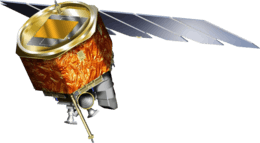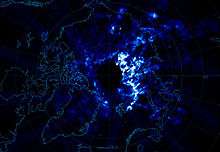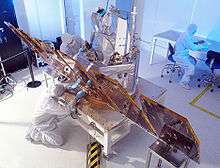Aeronomy of Ice in the Mesosphere
The Aeronomy of Ice in the Mesosphere (AIM) is a satellite originally launched to conduct a 26-month study of noctilucent clouds (NLCs). Its mission was extended, and as of 2019 is still operational.[3] It is the ninetieth Explorer program mission and is part of the NASA-funded Small Explorer program (SMEX). On April 25, 2007 AIM was boosted into a 600 km (370 mi) high polar orbit by a Pegasus-XL rocket, which was air-launched from the Lockheed L-1011 Stargazer aircraft operated by Orbital Sciences.[4]
 | |
| Mission type | Atmospheric research |
|---|---|
| Operator | NASA |
| COSPAR ID | 2007-015A |
| SATCAT no. | 31304 |
| Website | aim |
| Mission duration | Elapsed: 13 years, 1 month, 29 days |
| Spacecraft properties | |
| Bus | LEOStar-2 |
| Launch mass | 197 kilograms (434 lb)[1] |
| Start of mission | |
| Launch date | 25 April 2007, 20:26:03 UTC |
| Rocket | Pegasus-XL F38 |
| Launch site | Stargazer, Vandenberg Runway 12/30 |
| Contractor | Orbital Sciences |
| Orbital parameters | |
| Reference system | Geocentric |
| Regime | Sun-synchronous |
| Semi-major axis | 6,926.82 kilometers (4,304.13 mi)[2] |
| Eccentricity | 0.0005254[2] |
| Perigee altitude | 552 kilometers (343 mi)[2] |
| Apogee altitude | 559 kilometers (347 mi)[2] |
| Inclination | 97.90 degrees[2] |
| Period | 95.63 minutes[2] |
| RAAN | 159.47 degrees[2] |
| Argument of perigee | 213.55 degrees[2] |
| Mean anomaly | 15.06 degrees[2] |
| Mean motion | 15.06[2] |
| Epoch | 25 January 2015, 00:23:24 UTC[2] |
| Revolution no. | 42,300[2] |
Spacecraft and instruments
The AIM satellite is a 200 kg (440 lb), 1.4 m (4 ft 7 in) by 1.1 m (3 ft 7 in) spacecraft, powered by two solar arrays, carrying three instruments:[5]
| Illustration | Instrument Name | Abbr. | Description and scientific objective |
|---|---|---|---|
 |
The instrument has four cameras positioned at different angles, which provide multiple views of the clouds from different angles and will allow a determination of the sizes of the ice particles that make up the cloud. | ||
 |
The instrument records impacts from cosmic dust particles as they enter Earth's upper atmosphere. The instrument uses fourteen polyvinylidene fluoride detectors, which emit a pulse of charge when impacted by a hypervelocity dust particle (velocity 1 km/s (0.62 mi/s)). A measurement of the value and variability of the cosmic dust input will allow scientists to determine the role the particles have in PMC (Polar Mesospheric Cloud) formation. CDE is a nearly identical replica to the Student Dust Counter on the New Horizons mission.[6] | ||
 |
The SOFIE experiment use solar occultation to measure cloud particles, temperature and atmospheric gases involved in forming the clouds. The instrument will reveal the mixture of chemicals that prompt NLC's formation, as well as the environment in which the clouds form.[7] |
Noctilucent clouds
The noctilucent clouds AIM is to study, also known as Polar mesospheric clouds, occur in the Earth's atmosphere at high altitudes of roughly 80 kilometers (50 mi) above the surface, far higher than other clouds. The AIM mission will help determine what factors — temperature, water vapor, and dust particles — lead to the formation of these clouds. The clouds seem to be a relatively recent phenomenon: they were first seen in 1885, and lately seem to be occurring more frequently.[8] The clouds always occur during the summer season near the poles and the Northern season always starts around the same time. Scientists have found that the start of the Southern season can vary up to a month however.[9]


References
- ESA. "AIM (Aeronomy of Ice in the Mesosphere)". Retrieved 31 March 2020.
- "AIM Satellite details 2007-015A NORAD 31304". N2YO. 25 January 2015. Retrieved 25 January 2015.
- "NASA AIM web page".
- Jeanne Ryba (4 June 2007). "AIM Mission - Launch". NASA. Archived from the original on 16 March 2010. Retrieved 2010-03-16.
- Space Dynamics Laboratory (2010). "Programs: AIM – SOFIE". Utah State University Research Foundation. Retrieved 2010-03-16.
- "Cosmic Dust Experiment (CDE)". Hampton University. 2010. Retrieved 2010-03-16.
- "Solar Occultation For Ice Experiment". GATS, Inc. 2010. Retrieved 2010-03-16.
- "AIM — NASA Science". NASA. 2010. Archived from the original on 24 March 2010. Retrieved 2010-03-16.
- Fox, Karen. "Clouds, Clouds, Burning Bright". NASA.
External links
- AIM home
- SOFIE Instrument and science description, view or download data
- AIM Mission Profile by NASA
- Taking AIM at Night-Shining Clouds: 10 Years, 10 Science Highlights
.png)